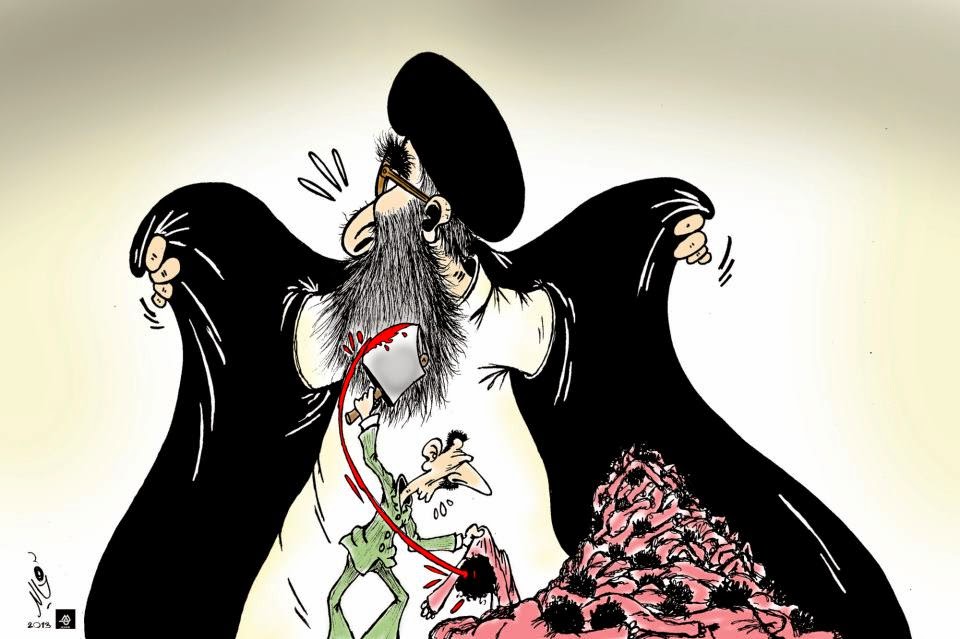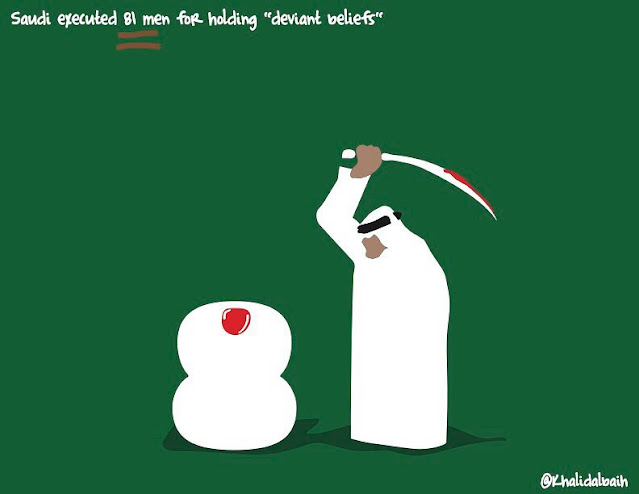Actors on the historical stage
"Images are not just a particular kind of sign, but something like an actor on the historical stage"
Oh yes.
 |
| Doaa Eladl, Eyes Wide Shut; Egypt in the Eyes of the International Press!! 16. august 2013. |
We shall return to the quotation, but let us first dive into an all too recent example of what imagery means to us. Between these two, the drawing above and the photo underneath there is but a span of two months. Doaa Eladl nailed the how and who of the unrest when Morsi fell from power all of which eluded the one-eyed press. It was there to see how the Brotherhood set fire to the Coptic churches for instance while there was a Brother constantly at hand to throw himself in front of the cameras. Victims always make for a great story.
The colors were not much different in the aftermath when daily life or something like a daily life was resumed. By then, however, some were no longer alive and the faces of two of them went viral at the time of their killings to a degree that they became an artistic statement too. Here they are both repeated in threes across a wall, playing along with the movement of a busy place as well as underlining their impact beyond their one figure frame.
 |
| Photo: Susan Aly, October 30. 2013. |
The police officer was filmed seconds after the murder as was Belal Ali Gaber. A youth with a bleeding gash right at his heart and half-closed eyes that could no longer see. The footage of him on the ground has been transferred onto the wall so that he seems to sink backwards away from us into the brickwork.
 |
| Photo: Abdelrhman Zin Eldin, October 15, 2013. |
He is composed in layers. The original photo has been projected onto paper for an elaborate paste-up, with the blood added afterwards, unto which the flowers were then placed. And so he himself somehow remains untouched.
 |
| Photo: Abdelrhman Zin Eldin, October 15, 2013. |
 |
| Photo: Abdelrhman Zin Eldin, October 15, 2013. |
The triptych to the left on the wall was made by Ammar Abo Akr, this time on his own, using the same paste-up technique to capture the features of Mariam Ashraf Mesiha:
 |
| Photo: Abdelrhman Zin Eldin, October 30, 2013. |
She was only eight, shot and killed on October 20 while on her way to a wedding at a Coptic Orthodox Church in Giza. Four persons were killed in the incident by unknown gunmen with automatic weapons on a motorbike.
Her cousin, the 12-year old Mariam Nabil Fahmy was killed too, hit in the abdomen, back, side and legs five times in all according to the autopsy, but the rumors said 13 times because of the state of her at the scene and the massive gruesomeness of her wounds is united with the unharmed face of Mariam splattered with red dots. She too has become a cherub with the wings of the all-seeing eyes.
 |
| Photo: Susan Aly, October 30, 2013. |
Two youths, one with eyes looking into a void, while the other is looking out at us. Those two were the ones whose faces are known and so their personal tragedy became a manifestation.
 |
| Photo: Abdelrhman Zin Eldin, October 30, 2013. |
And then the shock this Sunday, November 3:
 |
| Photo: Abdelrhman Zin Eldin, November 3, 2013. |
This is where W.J.T. Mitchell steps in with his quotation above. When I read his Iconology; Image, Text, Ideology (1986) back at uni, his straightforward stance was an eye-opener in all its simplicity: Idolatry and iconoclasm are two of the same kind.
Of course. Not that the use of images necessarily correlates to idolatry, but the recognition of their impact on us is shared by those who fear them. Maybe they even set them higher, acting as if images are alive, not just a suggestion of life. Which has a logic to it, images have after all a physical presence. A ruler is omnipresent when his image is everywhere, and rather than seeing his portraits as an representation, they are the first to be very actively destroyed to mark his fall from power.
 |
| Photo: Abdelrhman Zin Eldin, November 3, 2013. |
Defacing has a history as long as imagery itself, continuing the line of making images present or absent. Half a face signals that the god or king has fallen. But defacing works both ways. Chance has it in this case that they are so visibly present underneath that the first intention for creating them is made all the stronger. To the red paint streaming from her bullet wounds is now added the black bullet points. The front of their faces are heavily covered with paint, but sections of their heads have been left free. It is as if we can see them move underneath.
Rather than being washed out, a new layer has been added to both of them: We no longer see the void of his eyes. He is no longer a victim. He who seemed to be moving away from us, is an agens in that this was done to children. And if they were symbols in the first place of brutal and unnecessary violence, they now carry layers of present day Egypt.
 |
| Photo: Abdelrhman Zin Eldin, November 3, 2013. |
Significantly, the police officer is still untouched.
 |
| Photo: Abdelrhman Zin Eldin, November 3, 2013. |
ETA: The artist struck back!
All photos courtesy of their photographers and must not be reproduced without their permission.

